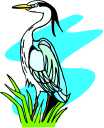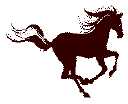
|
by
Neil Russack |
Excerpted
from the preface to Animal
Guides: In Life, Myth and Dreams
An Analyst's Notebook by
Neil Russack, appearing in Jung
at Heart, Number 36, Winter/Spring 2002. Inner City Books. All rights
reserved. Reprinted with Permission.

This book begins in water and flying. It begins with a waterbird.
One afternoon, in the woods of Montana, I left a Blackfoot Indian sweat lodge because I had begun to experience a tightening in my chest and thought I might have a heart attack. Exiled by my pain, I stood outside for some time, listening to the continuous chanting inside and watching the skin of the lodge turn white and begin shimmering.
For two days, curled on a makeshift bed in a yurt, I endured the pain. By the third morning I gave up all hope of freeing myself of both the pain and its underlying fear: “fear in the pit of your stomach,” the medicine man called it. In that moment of giving up, the image of a bird appeared to me. It was an egret, pure white, and wrapped around my heart. Gradually, very carefully, the elegant bird began to unwind its long legs and open its great folded wings. Unfurled, it flew out of my heart into the beyond. My pain left and I felt free. Much later I realized that the white bird had become this book.
The waterbird flies free across the waters, away from the known to the world beyond. As a dreamer, reader and therapist I witness this flight again and again. In a colleague’s dream a flock of geese suddenly becomes airborne, inspiring him to chance an artistic career. In a patient’s drawing, a duck fetches a woman who is trapped on dry land and carries her on its back into the waters. In the weeks that follow, the patient discovers that she is able to love for the first time. In a Japanese fairy tale, a man rescues a crane. In gratitude, this nonhuman female transforms herself into a woman and marries him.
The waterbird is a weaver, moving between the elements of water, air and land, stitching together the different worlds. Just as the waterbird can shift between realms and link them, this book will take you, the reader, in and out of many different realms. Along the way, you will hear various kinds of voices: the intimate accounts of those who come to see me as a psychiatrist, the stories of friends, and my own personal story, which is inevitably touched by what people bring to me. Threaded throughout are some of the great myths that belong to all of us.
We will meet other animals along with the waterbird. Each one has a unique voice, a voice you cannot find in a guidebook or a compilation of symbols. How the beast appears, what it brings, what emotion it evokes, what healing link it fashions: this is the story.
This is not a “how to” book. It is a book to stir the imagination. Animals link us to the mythic realm. They are messengers of the gods, and I hope that this book itself will become a kind of messenger, like the waterbird, attuning us to older and deeper ways of life. As you read, I hope that you will remember animals you have encountered— wild creatures, pets, dream animals— and that you will be touched as I have been. I hope you will be renewed through reconnecting to the animal life we humans left behind long ago.
This book is a map tracing journeys in which people are guided by animals into a richer humanity. Animals break down barriers and bring a healing presence into our lives. The waterbird, weaver of worlds, is the original and guiding image.
The story begins with my own early life, introducing the themes of alienation, the suffering that comes from being cut off from animal life, and the quest for love. Then a variety of healing paths are described, involving the initiations by animals into their elemental realms: air, water, earth and fire. In the final chapter, animals restore us to the human world.
The narrative has been guided by C.G. Jung’s diagnosis of the modern condition as a state of fundamental estrangement:
 Animal
Guides:
Animal
Guides:
